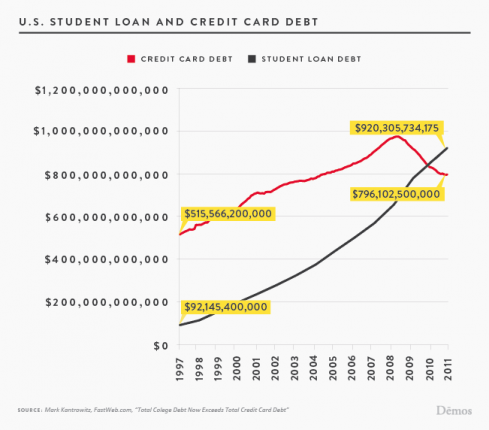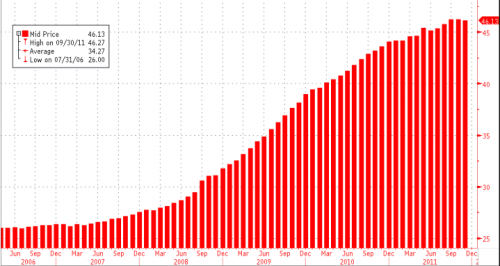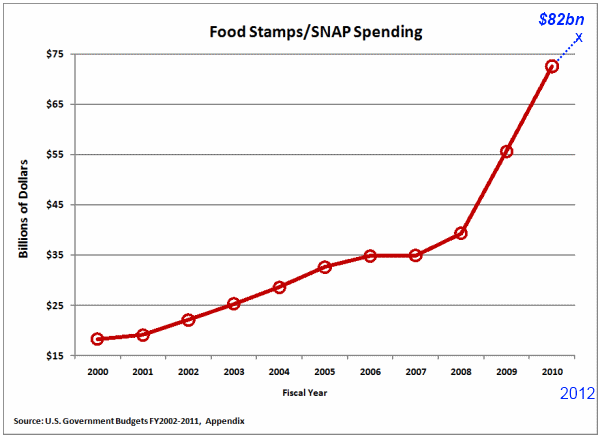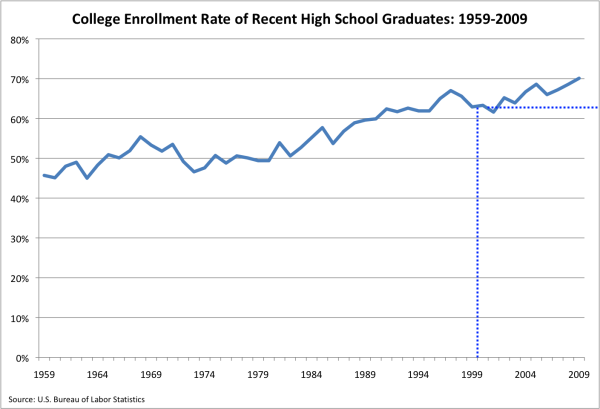The big swindle and a fog of debt – hiding the unemployed in the higher education bubble and three years of economic recovery equates to 11.5 million more Americans on food stamps.
- 8 Comment
A large part of our recovery is running on public relations trickery and smoke and mirrors debt machinery. Let me explain what I mean by this since on the surface we have been out of a recession since the summer of 2009. Government debt is soaring and public debt in certain sectors is flying off the charts. Take for example food stamp usage and student loan debt. These payments typically rise during tough times as would be expected. So you would conclude that being in year three of this so-called recovery that costs for both of these sectors would be retreating. You would be absolutely wrong in this Alice and Wonderland debt world. The student debt market has become a predatory landmine for prospective students and continues to grow like a wild fungus. Food stamp usage is expected to be high deep into 2014. Can you call it a recovery by using accounting magic that actually hides the continuing deterioration of the middle class?
Food stamp usage peaking during a recovery?
First, food stamp usage is at a peak:
Source:Â Zero Hedge
How is it a recovery when 15 percent of the population is receiving food assistance just to stay afloat? But examine the chart carefully. When the recession officially ended in 2009 there were 35 million Americans on food stamps. Today, three years later and deep into a recovery we have 46.5 million Americans receiving food stamps! In other words, food stamp usage has increased by more than 32 percent during the recovery. Since when does a recovery involve increasing the amount of Americans on food stamps?
There is a cost to having 46.5 million Americans on food assistance:
Source:Â Cato Institute
We amended the chart with the expected cost of the program for 2012 which will cost roughly $82 billion. In 2009, the year of the recovery, the cost of the program was running at roughly $40 billion. So the cost is now over double that since payouts have increased in conjunction with the wonderful hidden inflation we are seeing with food prices.
What does this say about our recovery? What it highlights is 46.5 million Americans are basically one EBT food debit card away from not eating.  We have seen an emergence of people crowding out Wal-Marts at the end of the month just waiting until the debit card is refilled so they can purchase food for their family. Does this sound like a recovery? This $82 billion is injected back into the economy and it is coming from the government but again, this is not a sustainable recovery as the media would like us to believe.
So you have to ask how is it that food stamp usage is still at a peak if we are truly in a recovery? This leads us into the other funny math being used with higher education and the bubble in student debt.
College enrollments soar during recession and hiding unemployment
Like food stamp usage, college enrollment typically edges up when the economy turns down as people go back to re-tool. But what happens when a big part of the system for re-tooling is largely run by scammers and paper mills? Americans are attending institutions of higher education at record levels:
You’ll notice the recent jump accelerated by the recession. Recent data for 2009 shows over 20,000,000+ Americans enrolled in degree-granting institutions. This is a 33 percent increase from 2000 while the population during this time increased by 8 percent.
A big part of the growth has come from the for-profit system. An interesting post came from someone working as a teacher at one of these places but sums up how the system works:
“This is probably true of all online universities, but basically it’s a genius scam. They’re setup exclusively to funnel federal student loan/grant money into their coffers. A student need be enrolled only four weeks and the school is entitled to 100% of the loan. Meaning, if the student drops out after Day 1, Week 4 — which a lot do — there is no refund. The school actively preys on people that will be most likely to receive federal assistance — poor people, single mothers, military personnel, etc.
The “Admissions Advisor” (see: telemarketer) who recruited the student will hold them by the hand up until week 4, in order to get his commission, then promptly ditch him.â€
I recommend people read the thread for the “quality†at some of these schools. This comes as no surprise given that most for-profits run by draining out government funding via debt. Many of these schools do not adequately explain the funding to students and saddle them with tens of thousands of dollars in student debt. This is why the student debt bubble is now quickly approaching $1 trillion:

It rather apparent that a massive bubble is going on and just like subprime loans being the tip of a bigger housing bubble, for-profits are simply the tip of a higher education bubble machine. Take a look at some of the institutions that enroll the most students in the United States:
Source:Â IPEDS, chart Wikipedia
Now you might be asking how this might be hiding the true nature of the recovery. Keep in mind that many people are currently in college because of the inability to find a job. These people are not counted in the employment figures as actively looking for work but in reality, if someone lost a job and is simply enrolled in some for-profit online taking out massive government loans to stay afloat and pay for school, this is simply buying time. We know from many reports that job placement rates for many for-profits are simply atrocious. Do you think that the millions of students enrolled will get top paying jobs once they graduate into the workforce and have the ability to payback those back breaking student debts? It would be one thing if this was 30 years ago and people were back in school at a local community college or an affordable state school since they wouldn’t be racking up the debt. Today, it is simply a method of going into incredible levels of debt and depending on the school and quality of education, might actually be a poor economic decision.
The fog of debt
Economic studies show conclusively that higher education enrollment and food stamp usage trend up when the economy is bad. We’ve been in a recovery for three years however. Yet student debt and food stamp usage continue to move upwards. Something seems to be contradicting itself here. Yet it does make perfect sense when you think about it. A large hidden economy is created. Roughly 2 million students are enrolled in the for-profits (10 percent of the 20 million) and how many of these would be actively looking for work if it were not for the ease of use of getting massive student loans to enroll? How many others are enrolled trying to retool but really looking for work? Add these 2 million or more students and the unemployment rate doesn’t look so rosy. The real winners seem to be the institutions and the banking system that services the loans. Show me a solid reputable study in regards to career placement for these for-profits.
The food stamp usage tells you the underlying story of a disappearing middle class. Having 15 percent of the population on food assistance is stunning especially when we are in a so-called recovery for three years. When we look at soaring government debt and banking chicanery we realize a giant fix is in. Most can examine the above charts and at the very least, really question the larger meanings of what it is to be in a recovery.
If you enjoyed this post click here to subscribe to a complete feed and stay up to date with today’s challenging market!
8 Comments on this post
Trackbacks
-
Dumbfounded said:
Pigs to the slaughter need a little fattening up first.
April 22nd, 2012 at 10:28 am -
fulano said:
the college attendance table should probably “*” the community college of the Air Force.
That is the career training school that is mandatory for all air force enlistees. No career training course progress and you are in deep trouble with your Sgt/supervisor.
Officers have a parallel career correspondence training set-up.
April 22nd, 2012 at 5:53 pm -
Bill said:
Don’t worry about food stamp spending increasing. Republicans are moving to cut food stamp spending as an excuse so they don’t have to cut defense spending. Do they really think that cutting food stamps will make us more secure?
April 23rd, 2012 at 5:54 am -
Jewell said:
Just watch the 2006 documentary “Maxed-Out: Hard Times, Easy Credit & the Era of Predatory Lending” for a good look at who really runs our country (hint: they have taken over $1 trillion of taxpayer money as bailouts while STILL continuing to pay themselves large salaries AND bonuses) and WHY things have gotten so much worse over the last 6 yrs since the release of that documentary.
Perhaps we’re seeing so many more on food stamps is because those people who have been unemployed or under-employed (relative to their previous level of employment & salaries) have now exhausted their personal savings & are desperately in need of help.
As for kids enrolling in college, for years we, as a society, have drummed it into kids’ heads that the only way to get ahead in life is through education.
April 23rd, 2012 at 10:09 am -
Hillary said:
you are absolutely right on the matter. I have seen numerous obama ads just twisting the truth on how great the administration is doing. I just hope this years elections will allow us to start fixing things.
April 23rd, 2012 at 10:34 am -
surfaddict said:
The simple solution to foodstamp bubble is to slash the generous benefits in half. This forces the recipient to focus on food staples, eat healthier, and avoid expensive processed foods. It also steers freeloader culture towards incentive to work.
April 23rd, 2012 at 10:40 am -
no6ody said:
”…many people are currently in college because of the inability to find a job. These people are not counted in the employment figures…”
but you can see the effects of this in the percentage of civilians employed in the following link:
http://research.stlouisfed.org/fred2/series/EMRATIO/
Seems like the percent of civilians employed is back to late 1970’s levels. Welcome to the economy of MoreWar.
April 23rd, 2012 at 5:36 pm -
Hillary said:
The thing that gets me is I don’t see it getting any better any time soon. People can’t even get underemployed at times.
June 18th, 2012 at 7:54 am




 If you enjoyed this post click here to subscribe to a complete feed and stay up to date with today’s challenging market!
If you enjoyed this post click here to subscribe to a complete feed and stay up to date with today’s challenging market!